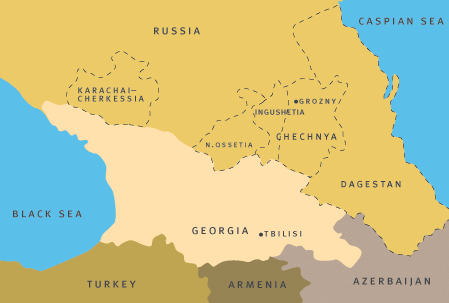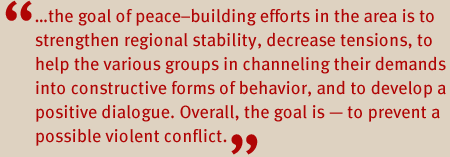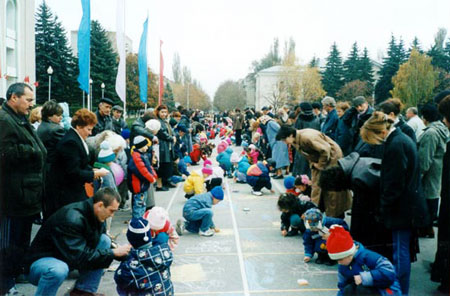


|
April 18, 2003
|
|||||||
|
The North Caucasus, with its chain of ethnic republics, remains the most troublesome region in the Russian Federation. On top of the economic and social problems that are common to all regions of Russia, the North Caucasus faces a number of particular difficulties: the continuing bloodshed in Chechnya, the high level of tension between different communities, and the legacy of earlier conflicts and natural disasters.
As a result, the region has become the focus of much international humanitarian effort – there are many assistance programs that have been organized by UN humanitarian agencies and by several other organizations. These programs cover a wide range of tasks, all aimed at helping the victims of the violent conflicts that have taken place in the North Caucasus. In 2001, according to the UN Office for Coordinating Humanitarian Affairs, over $80,000,000 was received by UN agencies and other organizations to provide humanitarian assistance to people in the region. This money has been spent on programs covering a wide range of different needs: protection of refugees, food aid, the provision of shelter, clean water and sanitation, mine clearing, the rebuilding of infrastructure, and medical assistance. However, while all of these are undoubtedly important, the scope of international involvement has remained limited. It has been focused on dealing with the consequences of conflict in the region, not its causes. There has not been a comparable effort to prevent future conflicts and foster peace between divided communities. Another weakness of the international humanitarian approach is that all action has been focused around the current war in Chechnya. Resolving the current Chechen crisis is of course paramount for securing a sustainable peace in the region – but it would be a mistake to overlook the problems created by earlier violent conflicts and, especially, to avoid supporting conflict prevention programs in other areas where tensions are high, and could escalate into full-scale conflict in the future.
This raises the question of whether there are ways in which civil groups in the region might not only address the consequences of conflicts, but also influence the course of events in areas where tension is high between communities or ethnic groups. Are there ways to work effectively outside the “humanitarian dimension,” or is this too much to expect from the poorly developed civil structures that are to be found today in the North Caucasus? A chance to put this question to the test was presented when the Moscow based Open Society Institute began to implement a program called “Hot Spots”. For the first time, a foundation working in the North Caucasus set itself the goal of developing practical peace-building initiatives in the region, rather than just supporting humanitarian and human rights programs.
Since 2001, OSI’s Hot Spots program has put in place a number of complex peace-building programs in several regions of the North Caucasus. These programs were designed to address the most serious problems faced by the local populations, to have an impact that would last beyond the duration of the projects themselves, and to be inter-connected, so that they would be mutually beneficial and have a cumulative effect. The aim was to identify specific issues that might generate conflict, and make them the focus of the projects. To receive funding, programs had to satisfy a set of requirements: they had to concentrate on a specific regional problem; to incorporate activities that involved a wide spectrum of the population; to include specific activities that promoted mutual understanding (meetings, cultural and sporting events, joint labor projects, round tables, etc.); and to encourage the various participants to work together in a co-ordinated way. The projects undertaken so far have been focused on three regions: the Karachai-Cherkess republic, north Ossetia and Ingushetia, and the Chechnya-Dagestan region. The Karachai-Cherkess Republic and Neighbouring Regions The Karachai-Cherkess republic is the only one of the regions that were chosen for the implementation of complex peace-building programs that has not experienced war in the last decade. Obviously, in such a situation, the goal of peace-building efforts in the area is to strengthen regional stability, decrease tensions, to help the various groups in channeling their demands into constructive forms of behavior, and to develop a positive dialogue. Overall, the goal is -- to prevent a possible violent conflict.
Despite the advantage of not having the legacy of a war to contend with, the situation in this region presents several problems. The local civic sector is poorly developed, even in comparison with other regions of the North Caucasus. There is no history of outside organizations working in the republic. Paradoxically, the fact that the region has not experienced first-hand the effects of armed conflict means that some groups – and especially some nationalist leaders – see armed struggle as a realistic (albeit perhaps distasteful) means of achieving their goals and objectives. And the struggle between different groups and individuals for control over property (which was experienced by all regions in Russia after the fall of the Communist system, and often was a prime source of conflict) remains much more acute in Karachai-Cherkessia than in most other Russian regions. At the heart of the tensions in Karachai–Cherkessia are divisions between the Turkic and the Circassian ethnic groups inhabiting the area: the Karachai and Nogai peoples on one side, and the Cherkess and Abazin on the other. Representatives of the different ethnic groups in this region have little direct contact, and the initial project here – “First Step to Mutual Understanding” – was aimed at selecting groups of people, from different social and political levels, who could form the basis for a constructive dialogue between the communities. However, as we move from Phase One to Phase Two in 2003 we need to prepare for an increase in internal tensions in the region, due to the upcoming Presidential elections, expected to take place this year. Thus, the projects that have been developed for 2003 are focused on engaging crucial groups of the population in dialogue and joint activities during the pre-election period. In North Ossetia and Ingushetia In the fall of 1992, a violent inter-ethnic conflict took place between the Ossetian and Ingush communities. The basis for this conflict, which had deep roots, was a dispute over territory in the Suburban district of North Ossetia (which the Ingush claim because it was part of the Chechen-Ingush republic before both peoples were deported to Siberia and Central Asia in 1944). Since 1993, a process of reconciliation between the two communities has been underway – but it has proceeded very slowly. There have been times when a resurgence of tensions has threatened to overwhelm the progress that has been made in the process of post-conflict recovery. The goal of civil peace-building programs in this region has been primarily to improve the moral atmosphere, to get rid of negative ethnic stereotypes, and to overcome the psychological barriers between the two communities. Many Ossetians who live in the conflict zone still maintain that the two communities cannot live side by side – a position that was officially voiced by the former leadership of their republic. The very slow process of resettling the Ingush refugees, which is far from being complete, has not been matched by any actual improvement in relations between the communities. Thus, if some of the obvious material consequences of the conflict are slowly being taken care of, this does not lead to an overall reduction in tension in the region. The return of Ingush refugees to their homes (which in most cases were destroyed) is not accompanied by genuine progress in the area of conflict management. Besides, the Suburban district of North Ossetia and the dispute over it are currently overshadowed by the war in Chechnya. Despite the difficult situation in the area, no international organizations are currently working there on a day-to-day basis. A number of international humanitarian organizations are present in Ossetia and Ingushetia, but they focus their activities on other tasks, mainly on the situation in Chechnya and refugees from that region (though some of them are carrying out short term programs in the Suburban district on an irregular basis). Nongovernmental organizations in Ingushetia are also primarily focused on the problems that are related to the war in Chechnya. The same is true of North Ossetia; there are a number of experts monitoring the situation, but until recently there have been no long-term NGO programs aimed at improving the situation in the Suburban district. Nevertheless, some short-term projects on this issue have been carried out quite successfully. In January 2001 the NGO “Caucasus Refugee Council” implemented a highly successful project to start a dialogue between Ossetian and Ingush young journalists. A similar project was implemented to establish contacts between scientists of the two republics. The experience of these projects turned to be very valuable for the development of the complex peace-building program in the region. The work of the complex program in this region has involved the mobilization of local non-governmental organizations in five specific areas: working with local media; working with children, teachers and social workers; building a dialogue between students in North Ossetia and Ingushetia; developing contacts between NGO’s in both areas; and giving legal advice to the population of the Suburban district and refugees. It is hoped to build on these efforts to create broad coalitions in both communities who are committed to a co-operative approach to reducing tensions. Chechnya and Dagestan This program focuses on the Hasavyurt, Novolak and Babayurt districts of Dagestan, and on a number of locations in the Chechen republic, along the administrative border with Dagestan. The situation in these areas is very difficult, for several reasons. There is the underlying issue of the “territorial rehabilitation” of the Chechen population of Dagestan, whose houses and lands were used to resettle other ethnic groups during the deportation of 1944-56. On top of this are a series of disputes relating to the migration of groups from the mountain areas of the republic into the plains, which has led to serious changes in the ethnic composition of the population and increased competition for limited land. And even in comparison to the rest of the Russian Federation, this region has seen a sharp drop in living standards over the last decade.
The continuing war in Chechnya has also had a damaging effect on the surrounding region. It has led to a significant number of refugees entering Dagestan, complicating the situation there. In addition, attacks by militants from Chechen territory against some of the villages in the Botlih and Novolak district have caused a deterioration in the relationship between the local Chechens and other peoples of Dagestan. Nevertheless, the Hasavyurt region of Dagestan offers the precedent of an earlier experience in managing inter-ethnic tensions so as to avoid the risk of violent conflict. In the late summer of 1999, extremist groups from Chechnya launched attacks into a number of villages in Dagestan. The immediate result was a worsening of relations between Chechens already resident in Dagestan, and the other local ethnic groups. Relations were already difficult. Chechens were deported in 1944 from the Auhov (now known as the Novolak) district of Dagestan. After they returned from exile they were not able to come back to their houses, since there were other people living there, mainly Laks (another ethnic group in Dagestan) who were "resettled" there from mountainous areas of the republic. The Chechens were given small plots of land in the neighboring Hasavyurt district, but they continued to press for the return of their original houses. As a result in 1991 there was an unprecedented decision made in Dagestan to move the Lak people from the district to a new district, created north of the republican capital, Mahachkala and to allow the Chechens to return to their homes. However, partly because of lack of money and poor management, the program that was adopted in 1991 is still only in an early stage of implementation. Against this background, the incursions of fighters from Chechnya led to a rapid growth of anti-Chechen feeling. The situation was further aggravated by the fact that many local militias had developed in Dagestan. These consisted of people who were officially allowed to carry weapons, but were only under the loose control of official authorities. Provocative leaflets began to circulate in the republic, and there were clashes between militia groups of local Chechens and people of other ethnic backgrounds. In this explosive situation, an independent group of Dagestan Chechens known as “SOS-Salvation” was able to play a valuable role in reducing the danger of conflict. It relayed information about the situation to federal authorities, who could pressure the regional leadership to avoid escalating tensions. It organized local meetings of elders or religious leaders, feeding into traditional methods of reconciliation, and promoted a public understanding that the Dagestan Chechens should not be held responsible for terrorist attacks launched from within Chechnya itself. Following on from this start, the first efforts at peace-building in the region have included: organizing meetings of the elderly, holding joint prayers for peace and other traditional activities; holding joint sports events for the young, between neighboring villages along the administrative border between Chechnya and Dagestan, and wherever possible including federal servicemen as participants in these events; distributing information about the culture and history of the different peoples of the area, and organizing cultural events. Building on this foundation, the priority of the “Hot Spots” program in this area is now to move to the new goal of using the possibility of cross-border cooperation to support stabilization efforts in Chechnya itself. A series of round tables was organized with representatives of different professional groups of the two republics. The ideas that were collected during these round tables have become the base for designing the second phase of the Complex Peace-Building Program in the area. Though it is difficult to measure the precise influence of these projects on the situation in the regions concerned, the fact that in 2003 it is possible to set objectives that would have been considered unrealistic just a year ago, shows that progress is being made. Andre Kamenshikov is Director of Non-Violence International - Newly Independent States.
|
|||||||
This site © Crimes of War Project 1999-2003 |
By Anthony Dworkin |
|
|
By Pavel Felgenhauer |
|
|
By Thomas de Waal |
|
|
By Andre Kamenshikov |
|
|
By Anne Nivat |
|
|
By Alice Lagnado |
|
|
By Thomas Dworzak |
|
|




